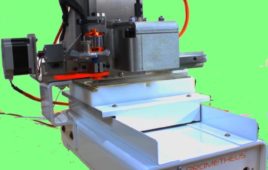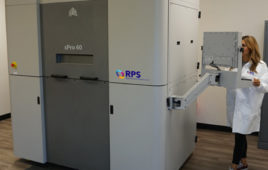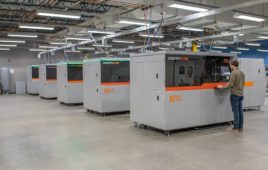David Moinina Sengeh considers himself a lucky man — and one who feels the importance of living every day to the fullest. During Sierra Leone’s fierce civil war, as bands of child-soldiers roamed the country committing murder and mayhem, he and his parents and four siblings escaped unharmed.
But his family and friends were not entirely unscathed: Two uncles were brutally killed, and a stray bullet killed a girl who lived next door. “Anybody who lived in Sierra Leone got affected by the war,” says Sengeh, now a doctoral student at the MIT Media Lab.
At the Media Lab, Sengeh is working to improve prosthetic limbs. In Sierra Leone — where amputations were used to instill fear during the civil war — many people don’t wear their prosthetic limbs because the hard plastic sockets don’t fit well. Sengeh has been working to produce custom-fitted, yet affordable, sockets.
In fact, his innovations could improve the fitting of prosthetics for amputees around the world. Today, he says, most amputees suffer some discomfort from the sockets of their prosthetic limbs. Sengeh is working to alleviate this with a new kind of variable-resistance socket that uses computer-aided design and manufacturing to produce a multilayer 3-D printed socket made of materials with different degrees of stiffness, customized using MRI of the patient’s residual limb.
But in addition to this work, Sengeh also finds time to reach out to the people of his home country, showing them the life-changing value of innovation and invention.
Bringing innovation home
Last spring, Sengeh created a program to foster innovation among high-school students in Sierra Leone. Called Innovate Salone, the concept was modeled after MIT’s innovation competitions, in which teams work on the creation of new devices or services.
But more than just a competition, Innovate Salone is a mentorship program and set of workshops where Sierra Leone’s youth can get help in developing their ideas. In just six weeks, the program attracted 300 students who worked on 72 different projects, Sengeh says, related to health, agriculture, household chores, crafts and entertainment. The idea was to “get people in the community to think about innovations that they can embrace, to have a positive impact on society [and] to get high-school kids around the country to think about a problem, and how to solve it.”
Previously, Sengeh says, “Many of them had never made stuff before.” A team of local and international judges selected eight finalists, each of whom received $500 to continue development of their projects. Winning projects included an electric broom, a project for dyeing fabrics, an aquaculture pond to provide fresh fish, and a homemade FM transmitter to provide neighborhood news and entertainment.
The transmitter was built by Kelvin Doe, then a 15-year-old student, who had previously figured out how to make his own batteries from discarded materials. (Doe had become frustrated by the high cost of batteries to run radios and flashlights.) Using the transmitter — which was built from salvaged parts — he broadcast his own local programming under the name DJ Focus. Doe soon enlisted the help of schoolmates, with an average age of 12, to help him gather news to broadcast on his station.
Sengeh, impressed with Doe’s creativity, arranged a trip for him to the United States. (Doe had never before traveled more than 10 miles from his home.) During this visit, in October, Doe was a featured speaker at the World Maker Faire in New York, spent time as a resident practitioner at the MIT Media Lab, and even met with Harvard University President Drew Faust. A video Sengeh subsequently made about Doe’s trip went viral, viewed more than 3.5 million times in its first few weeks on YouTube.
As a result of the attention, donations have flowed in, Sengeh says: Several U.S. schools have offered Doe scholarships, and people have been inspired to work on innovations for communities in nations including Colombia, Brazil, Vietnam and Botswana.
Home-grown solutions
Sengeh’s impetus for starting Innovate Salone was the realization that the innovations he was working on at the Media Lab, while useful, were too expensive to benefit most people in the developing world. “I wanted to empower young people to develop their own solutions,” he says. His competition received support from MIT’s Public Service Center, Sierra Leone’s education ministry, and several foundations.
Sengeh invited Innovate Salone finalists to a summer “innovation camp” to continue their work, with help from mentors and with presentations by teachers from the University of Sierra Leone and from UNICEF. (Doe provided nightly entertainment with his FM transmitter.) At the end of the summer camp, each team received another $1,000 to further develop their projects.
The second year of the competition is now underway, Sengeh says. The nonprofit organization is still trying to raise money to maintain the project and create at least two permanent “maker centers” in Sierra Leone: workshops where young people can work on their projects, with access to tools and equipment, and instruction and guidance..
“I’d like to see many more kids participating in innovation,” Sengeh says.
Accessible technologies
Inspired by an uncle who is a surgeon, Sengeh — who attended Harvard as an undergraduate after applying on a whim — initially considered a career in medicine. “He would often do surgery for free,” he says of his uncle. “He is one of my main heroes.”
But after seeing the limited tools and resources available to physicians in his native country, Sengeh became interested in developing medical technologies — especially ones that would be affordable in the developing world.
Sengeh’s strongest impulse remains the desire to empower people to find their own solutions. That sense of putting power into people’s hands is reflected in Innovate Salone’s slogan: “We all de mek am,” which translates as, “We are all the makers.”
For more information visit www.mit.edu.
Filed Under: Student programs, Rapid prototyping




